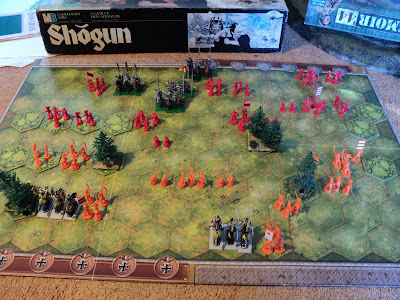 |
| Battle of Azukizaka, 1542 |
This particular battle seemed to me good for a good and proper playtest of the Portable Sengoku Wars (PSW) rule set 'as she was wrote'. But... not... quite. I still wanted the Army HQs to be static pavilions. But otherwise, there was to be but one 'general' only. I won't go into the historical background, but summarise the action, with particular comments upon the activation of units. The diagram was taken from the Zvezda Art of Tactic scenario, translated onto my Memoir '44 battle board.
 |
| Purple Army wins the first initiative dice roll... |
The forces were:
Clan Yoshimoto (Purple):
1 Commander (Yashimoto) and HQ in pavilion (elite) : 4SP*
2 Mounted Samurai (units) (average) @ 3SP = 6SP
2 Foot Samurai (elite) @ 4SP = 8SP
4 Ashigaru Yari (average) @ 3SP = 12SP
4 Ashigaru Tepo (average) @ 2SP = 8SP
13 units, 38 SP
Exhausted on losing 13SP, rout on losing 19SP
 |
| Yoahimoto Cavalry and HQ in the distance. The latter is indicated by the white fan-like flag. |
Clan Nobuhide (Red):
1 Commander (Nobuhide) and HQ in pavilion (elite): 4SP*
2 Mounted Samurai (average) @ 3SP = 6SP
2 Foot Samurai (elite) @ 4SP = 8SP
5 Ashigaru Yari (average) @ 3SP = 15SP
3 Ashigaru Tepo (average) @ 2SP = 6 SP
13 units, 39SP
Exhausted on losing 13SP, rout on losing 20SP
*the HQ SPs are associated with the Daimyo's immediate bodyguard and entourage, not the commander himself. That august personage lends the weight of his leadership to this elite unit, and lives and dies by it. Neither may move, nor may they initiate a close combat.
 |
| Nobuhide cavalry and HQ 'pavilion'. The latter is represented by the seated diamyo, the parasol, and the spearmen. |
What I wanted to do was to examine closely the workings of the activation system with just one overall commander in each army. With 13 units the side, divided by 6, we get 2D6 plus 1 for the commanders. Three D6 dice rolled for activation, the scores divided by two.
 |
| First blood to Yoshimoto: a Red ashigaru tepo bites the dust. |
Yoshimoto (Purple) won the first turn initiative, and then rolled 3D6 for activation. The scores were 4,1,1. Summed and then divided by 2, yielded just 3 units activated. Purple contented himself with some indifferent arquebus fire and a small local attack, although a Red tepo figure was knocked over on their left wing. Nobuhide's activation roll was no more impressive: again just 3 activations, with not a lot achieved. Three activations from thirteen units, ain't exactly clobbering time!
 |
| The beginning of Red assault upon the Purple right wing. |
Things improved subsequently, with activation rolls yielding 5 and 6 units getting into the action, but it would have taken a roll of 14 with three dice (e.g. 4,5,5, or 3,5,6) to activate 7 units - only barely more than half the army. During this battle such a score was never achieved. Not to be wondered at: the probability of scoring 14+ with 3 D6 dice is a whisker less than rolling a 6 on a single D6 die.
 |
| General view |
 |
| Big melee in the centre |
 |
| Red crushes the Purple right wing. |
 |
| Mutual exhaustion, losses nearly equal. |
By this time, the Purple army had been reduced by losses to below its exhaustion point. In trying to hustle the enemy from the field, the Red army also fell below its exhaustion point (13SP lost). The battle sputtered to a close, the outcome indecisive.
It felt to me frustratingly difficult to get much action going in this battle. At no time was even as much as half the army able to move, shoot or engage in close combat. But why am I complaining? Am I complaining? I'm not sure! That is the way Memoir '44 often plays, and I have no problem with that!
I still like my addition of sub-generals, though, to Antoine Bourguilleau's activation procedure. In addition to the overall Army commander, one might be allowed 1 sub-general for every whole multiple of 6 units in the army. The number of activation dice is equal to
- 1 for every whole multiple of 6 units (another way of expressing the 'book' method);
- +1 for the Army commander;
- +1 for every sub-general.
What would be the statistical expectation of the number of units of this army activated in any given turn? The expected score with 7 dice is 24.5. Then the expected activation is half that, that is to say 12 units - two-thirds of the army. Note that, the moment this army lost a unit, its activation dice gets reduced to 6 - the expected unit activations reduced to 10 or 11. The activation dice go as much for command and control as for the size of the army. I should mention that, as in my suggested scheme of things a general lives and dies with his unit, the loss of a general implies an immediate loss of an activation die, and the loss of the unit as well might imply the loss of yet another activation die.
For mine, what appeals is that you get enough uncertainty to satisfy that criterion for solo games. In fact you get quite a spread of possibilities. It is possible, however remotely, that in a given turn the whole army might be activated; but also possible that you might get to move just 3 or 4 units. You can develop large scale attacks and manoeuvres, but there is always a chance that a poor activation roll will bring it all to nought.
This notion will come in for more play tests in due course.



















